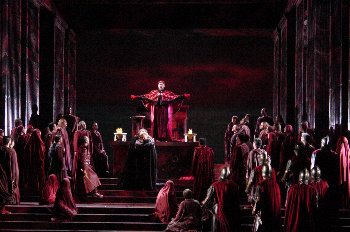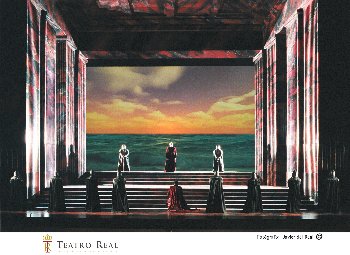Teatro Real, Madrid, Premiere October 1, 2002
Impressions and contents Part
1 - Part
2 - Part
3
Simone Boccanegra

Photo: Birgit Popp
With a from all sides applauded, splendid
performance of Verdi's Simone Boccanegra the Teatro Real in Madrid (ESP)
opened on October 1 its fifth season since its reopening in 1997. Stage
director Giancarlo del Monaco and his stage and costume designer Michael
Scott have created together with the light designer Wolfgang Zoubek a
completely rounded work with an intensive atmosphere and magnificent
design. The five protagonists of the first night - Alexandru Agache
(Simone Boccanegra), Elisabete Matos (Amelia Grimaldi), Giacomo Prestia
(Jacopo Fiesco), Marco Berti (Gabriele Adorno) and Anooshah Golesorkhi
(Paolo Albani) - have been in as good form as the orchestra under the
baton of Gabriele Ferro.
In
detail
About
the production
Also
in the year after the Verdi Year 2001, the 100th anniversary of the
death of the Italian composer, Verdi tops the programs of the opera
houses. Still before the Simone Boccanegra premiere at the Vienna State
Opera on October 14, 2002, which is a co- production with the Salzburg
Festival, celebrated Verdi's drama about a lost- and- found daughter its
first night in a new production of the Teatro Real at Madrid (ESP) on
October 1, 2002. The opera house at Madrid started with Verdi's opera
into its fifth season since its reopening
with de Fallas La vida breve and the world's premiere of Abril's
Divinas Palabras in 1997.
For
the Madrid production of Simone Boccanegra, for whose libretto Francesco
Maria Piave took the play Simone Boccanegra (1843) written by the
Spanish
novelist Antonio Garcia Gutíerrez as base, nobody less than
Giancarlo del Monaco shows responsible. He put on stage a visually
opulent piece, what was considered by some critics for too traditionally,
but found the unanimous agreement of the Madrid audience. A first night
without any booing is quite seldom for the Madrid opera house. Giancarlo
del Monaco has chosen as basic for all three acts an uniform stage
design, which remembers at columns of red marble and should reflect the
giant ambitious of all dictatorships. The aspect that Simone Boccanegra,
though a loving father and sensitive human being, is nevertheless
finally a dictator plays in the eyes of del Monaco in this production an
important part. But, different to his New York production of the
nineties the sea does not only exist in the head of the protagonist –
this time it is always visually present. Besides during the prologue it
has a movie in the back with a moving sea and a sky with passing-by
clouds. According to the musical atmosphere the sea is more stormy or
calmer. The basic color of the production is red. This reflects in the
red-marbled walls, in the splendid costumes, who fit to the time of the
libretto in the 14th century, and in the colors of the sea and the
heaven.
Altogether a very evocative stage design.

About
the music
When
Simone Boccanegra was performed first in the Teatro La Fenice at Venice
in 1857, it was not destined to succeed. In spite of several reworkings
through the composer also in later appearances it did not change to the
better. The success should come not earlier as with the in 1880 done
reworking by Arrigo Boito, who tried to eliminate some of the weak
points of the libretto. The first performance of this version at the
Scala di Milan in 1880 was a triumphal success. Nevertheless, it should
take till the thirties of the 20th century, till victory came also
outside Italy like in Berlin or at the MET in New York.
In
the musical work of Verdi is Simone Boccanegra an important landmark on
his way from the opera with different numbers to the psychologizing
music drama. Also the musical director of the Madrid production Gabriele
Ferro agrees to this opinion, "It is the first opera, in which
Verdi uses the recitatives in another way, in a more combining manner.
The instrumentation and the colors in the orchestra give more a
symphonic idea than in his works before, though Verdi stays in the
tradition of the Italian opera." And the son of the Italian
composer Pietro Ferro continues, "It is the first time that Verdi
creates a picture of the sea by the orchestra. At the beginning of the
first act the listeners get the feeling that they can hear the sea –
something like this it never had before in the works of Verdi. Also the
whole structure of this opera is different to the proceeding ones. For
example, Simone Boccanegra does not have a real aria."
About
the casts
Since
it has during a series of one opera almost each night a performance at
the Teatro Real, it had two casts for Simone Boccanegra. The cast of the
first night saw Alexandru Agache in the title role of Simone Boccanegra.
The Romanian baritone, who has sung this role already at the Covent
Garden in London, at the MET in New York and in the Bastille at Paris,
embodied this role of the cosar, who becomes the Doge of Genoa, with
great personality and dignity and most times with a good vocal presence,
which got some times lost in the recitatives. In the shaping of the
recitatives as well as in the piani Carlo Guelfi was very convincing as
Simone Boccanegra in the performance of (October 2, but he was missing
the powerfulness and the richness in the lower registers of the voice.
With the final duet of Fiesco (bass) and Simone (baritone), when the due
to Paolo's poison dying Simone reveals to his enemy Fiesco that Amelia
is his grand-daughter, and finally the two men are reconciled, Verdi has
written one of his most beautiful bass-baritone-duets. In the role of
Fiesco stands with great bass power and vocal expressiveness the Italian
bass Giacomo Prestia on the stage of the first night.
Andrea Papi of the second night does not have to hide behind him.
The role of Amelia is casted very differently with Elisabete Matos and
Carmela Remigio. In the first night Elisabete Matos, who had been
standing in Divinas Palabras next to Plácido Domingo already on the
stage of the Teatro Real, did not totally mach her usual vocal
brilliance. In the heights the voice of the soprano, who has become
meanwhile an acclaimed Wagner interpret, became a bit sharp and got some
tremolo. With more sensibility, vocal smoothness and secure heights sung
Carmela Remigio the part of Amelia at the following evening. In the
premiere Marco Berti gave the Gabriele Adorno with a powerrful shining
tenor, glowing heights and self-confident stage personality. His role
debut celebrated Nicola Rossi Giordano as Adorno on October 2. He
designed the role compared to Marco Berti with more sensibility and more
emphasis on the piani, but had with his nicely colored tenor still
sometimes problems in the transitions from the medium into the higher
ranges. The Italian singer, who is in his mid-thirties, has come to sing
operas only two years ago and stands still at the beginning of a
certainly with attention to follow career, which has allowed him to sing
already roles like Radmès (Aida), Pollione (Norma) and Pinkerton (Madama
Butterfly). Vocally and visually he meets the requirements for a
successful career and it does not have too many tenors in his repertory
of international level. A good figure vocally as on the acting part
makes as well Anooshah Golesorkhi as Paolo Albani, who is singing in all
performances. The US American baritone, who has been singing among other
roles already Nabucco at the Vienna State Opera and the MET, counts also
the role of Simone Boccanegra to his repertory. His Paolo makes curious
to hear more from him. The choir of the Madrid Symphonic Orchestra
offers a nicely colored, precise sound. The orchestra under the baton of
Gabriele Ferro plays in a singer-friendly manner, has its absolute
highlight in painting the sounds of the sea in the beginning of the
first act producing a wonderful symphonic sound and it knows to deepen
the melancholic-gloomy general atmosphere.
Birgit
Popp
Impressions and contents Part
1 - Part
2 - Part
3
Bericht
SIMONe
BOCCANEGRA
Opera
in one prologue and three acts
Musik/Music:
Giuseppe Verdi (1813 - 1901)
Libretto:
Francesco Maria Piave und/and Arrigo Boito
|
Dirigent/Conductor
|
|
Gabriele
Ferro
|
|
Regisseur/Stage
director
|
|
Giancarlo
del Monaco
|
|
Ausstatter/Designer
|
|
Michael
Scott
|
|
Licht/Lightning
|
|
Wolfgang
Zoubek
|
|
Chordirektor/Director
of the choir
|
|
Martin
Merry
|
|
|
|
|
|
Simone
Boccanegra
|
|
Alexandru
Agache (1, 3, 5, 8, 10, 13, 15)
Carlo
Guelfi (2, 7, 12)
|
|
Amelia
Grimaldi
|
|
Elisabete
Matos (1, 3, 8, 10, 13)
Carmela
Remigio (2, 5, 7, 12, 15)
|
|
Jacopo
Fiesco
|
|
Giacomo
Prestia (1, 3, 5, 8, 10, 13, 15)
Andrea Papi (2, 7, 12)
|
|
Gabriele
Adorno
|
|
Marco
Berti (1, 3, 5, 8, 10, 13, 15)
Nicola Rossi Giordano (2, 7, 12)
|
|
Paolo
Albani
|
|
Anooshah
Golesorkhi
|
|
Pietro
|
|
Victor
Garcia Sierra
|
|
|
Chor
des Sinfonie-Orchesters von Madrid
Sinfonie-Orchester
Madrid
|
Vorstellungen: 1., 2., 3., 5., 7.,
8., 10., 12., 13., 15
|